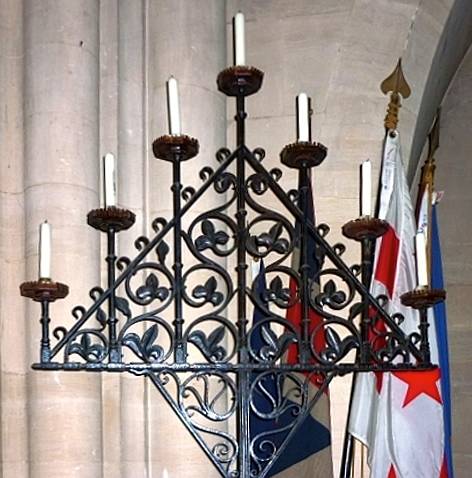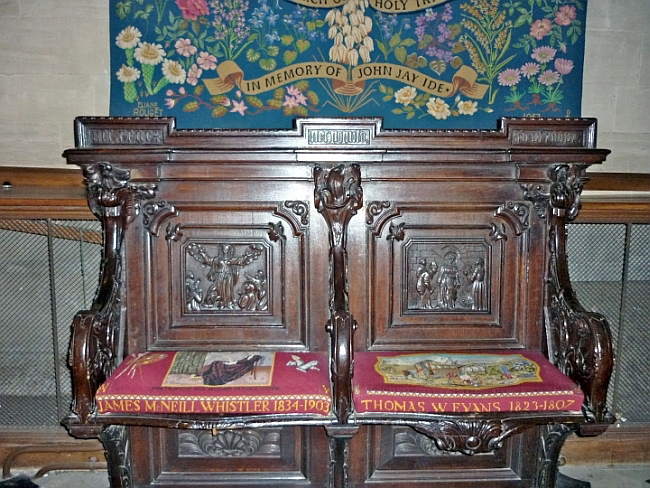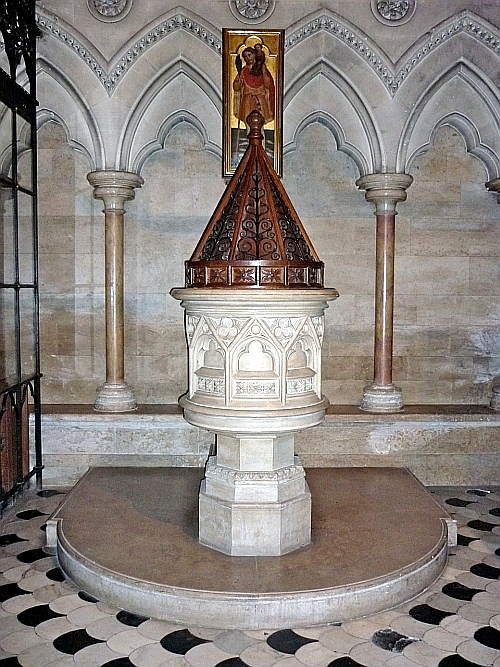
The American Cathedral of the Holy Trinity, Paris
George Edmund Street (1824-1881); completed by Arthur E. Street and Arthur Blomfield
1882-6
St Maximin and Savonniere stone, and marble
23, Avenue George V, Paris
Photograph and text Jacqueline Banerjee, 2010
[You may use this image without prior permission for any scholarly or educational purpose as long as you (1) credit the photographer and (2) link your document to this URL or cite it in a print one.]
Commentary
George Edmund Street's son records how, immediately after having been shown the site acquired for the proposed church, his father was able to sketch it in some detail very much as it now stands. Of course, there were to be some modifications. However, Arthur Street says: "Every proportion is exactly similar. The height of the church in relation to its width, the design and proportions of the tower and spire, the proportion of the whole to the site on which it stands." What the younger Street finds so impressive here is not so much his father's artistry and skill, as his imaginative power and "self-reliance" in thus setting out, without hesitation, his vision of the costly church to be sited "in a grand and splendid foreign capital as a monument of what the boasted English school of church architects could accomplish" (134).




Left to right: The chancel, with its altarpiece by Arthur Street and the American Pre-Raphaelite Edwin A. Abbey, depicting (l. to r.) the Nativity, the Crucifixion and the Resurrection. (b) The lectern designed by the original architects. (c) An example of the fine wrought-iron work also designed by the original architects. (d) The West Window, installed in 1887, and the organ.
Oak seating with needlepoint cushions honouring two prominent Americans-in-Paris, the artist John McNeill Whistler (1834-1903) — note the famous portrait of the artist's mother on the cushion — and the famous dentist Thomas W. Evans (1823-1897) who ministered to Napoleon III and help found the American Register (newspaper) in Paris in 1868; John Jay Ide, remembered in the tapestry behind, was the first Chief Justice of the United States (he had studied at the École des Beaux Arts in Paris). (b) Elegant but unfussy stonework, typical of Street. (c) Font designed by the original architects. Like Street's other large-scale commissions, this cathedral too has "a marked beauty of outline" (Arthur E. Street 204). It is beautiful inside as well as out, with state flags hanging above the nave, and fittings, notably the font and lectern, designed according to the Cathedral's own website "by the architects" — which perhaps suggests that the designs were based on sketches by Street himself, or with his earlier church furnishings in mind, and carried through by his son and Blomfield. Taken as a whole, it is an astonishing piece of English Gothic Revival architecture to come upon in the heart of Paris, and has a welcoming atmosphere. Even though he died so early in the building's history, George Edmund Street certainly fulfilled his remit here. "Architecture & Art" (The American Cathedral's own website). Web. 8 Dec. 2010. Street, Arthur Edmund. Memoir of George Edmund Street, R. A., 1824-1881. London: John Murray, 1888. Internet Archive. Web. 8 Dec. 2010.


Related Material
References
Victorian
Web
Archi-
tecture
Gothic
Revival
G. E.
Street
Next
Last modified 8 December 2010